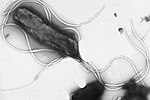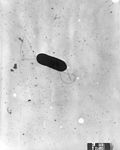Virulence factors (preferably known as pathogenicity factors or effectors in botany) are cellular structures, molecules and regulatory systems that enable...
15 KB (1,871 words) - 07:36, 25 March 2024
disease—is determined by its virulence factors. In the specific context of gene for gene systems, often in plants, virulence refers to a pathogen's ability...
10 KB (1,170 words) - 20:57, 25 September 2024
Bordetella (redirect from Bordetella virulence factor)
influx, may also contribute to the intoxication of phagocytes. The virulence factors identified in the Bordetella are common to all three species. These...
22 KB (2,573 words) - 18:29, 3 October 2024
opportunistic pathogen that secretes immune-modulating virulence factors, has many adhesion factors, and the potential to create biofilms, all of which help...
35 KB (3,679 words) - 23:12, 27 August 2024
To successfully colonize its host, H. pylori uses many different virulence factors including oxidase, catalase, and urease. Urease is the most abundant...
148 KB (16,625 words) - 19:18, 2 October 2024
Streptococcus pyogenes (section Virulence factors)
for serotyping S. pyogenes based on its cell-wall polysaccharide, a virulence factor displayed on its surface. Later, in 1946, Lancefield described the...
41 KB (4,042 words) - 12:33, 8 October 2024
a relationship between disease severity and the expression of the virulence factors Streptolysin S and SPEGdys has been inferred. Penicillin remains the...
40 KB (4,576 words) - 04:21, 22 January 2024
capsule that acts as a virulence factor for the organism; more than 100 different serotypes are known, and these types differ in virulence, prevalence, and...
32 KB (3,298 words) - 12:50, 9 September 2024
Trichomonas vaginalis (section Virulence factors)
the receptor molecules on VECs. Cysteine proteinases may be another virulence factor because not only do these 30 kDa proteins bind to host cell surfaces...
33 KB (3,361 words) - 17:48, 10 October 2024
Corynebacterium striatum (section Virulence factor)
itself possesses few virulence factors, giving it the title of an opportunistic colonizer as opposed to a true pathogen. Virulence arises from its antibiotic...
27 KB (2,898 words) - 21:36, 16 June 2024
Gas gangrene (section Virulence factors)
Members of the Clostridium genus exhibit a plethora of virulence factors. Common virulence factors associated with gas gangrene include alpha toxin and...
21 KB (2,258 words) - 06:47, 15 July 2024
Yersinia pseudotuberculosis (section Virulence factors)
response. Since this pathway gives secretion selectivity, it is a virulence factor. In contrast to the ysc and yop genes listed above, the Yops that act...
31 KB (3,565 words) - 21:36, 13 July 2024
Necrotizing fasciitis (section Risk factors)
two major toxins: all known virulent strains produce the essential virulence factor lethal toxin (TcsL), and a number also produce haemorrhagic toxin (TcsH)...
45 KB (4,681 words) - 00:04, 17 September 2024
Staphylococcus aureus (section Virulence factors)
poisoning. Pathogenic strains often promote infections by producing virulence factors such as potent protein toxins, and the expression of a cell-surface...
114 KB (12,721 words) - 16:39, 4 October 2024
(ed.). "The Probiotic Bacterium Phaeobacter inhibens Downregulates Virulence Factor Transcription in the Shellfish Pathogen Vibrio coralliilyticus by N...
12 KB (1,353 words) - 08:46, 5 May 2022
species' pathogenicity. P. aeruginosa uses the virulence factor exotoxin A to inactivate eukaryotic elongation factor 2 via ADP-ribosylation in the host cell...
92 KB (10,021 words) - 10:24, 7 October 2024
Streptococcus agalactiae (section Virulence)
other virulent bacteria, GBS harbors an important number of virulence factors (virulence factors are molecules produced by bacteria that boosts their capacity...
49 KB (5,950 words) - 13:28, 19 August 2024
Salmonella (section Switch to virulence)
they form virulence factors and as such regulate the switch from their normal growth in the intestine into virulence. The switch to virulence gives access...
71 KB (8,208 words) - 23:01, 9 October 2024
Sporothrix schenckii (section Virulence factors)
synthesizes melanin both in vitro and in vivo Melanin production is a virulence factor found in many fungi that cause disease and its production in S. schenckii...
27 KB (2,926 words) - 21:10, 6 April 2024
Staphylococcus epidermidis (section Virulence factors)
needed] The ability to form biofilms on plastic devices is a major virulence factor for S. epidermidis. One probable cause is surface proteins that bind...
28 KB (2,880 words) - 10:58, 11 August 2024
infections (UTIs), meningitis, and other infections in humans. Several virulence factors are thought to contribute to E. faecalis infections. A plasmid-encoded...
27 KB (3,039 words) - 18:56, 30 September 2024
Francisella tularensis (section Virulence factors)
bacteria to act as a hemolysin, whereas in Francisella, its role as a virulence factor is under vigorous debate. F. tularensis contains type VI secretion...
18 KB (2,028 words) - 14:53, 18 September 2024
Porphyromonas gingivalis (section Virulence factors)
Stemmet M (July 2014). "Anaerobes and bacterial vaginosis in pregnancy: virulence factors contributing to vaginal colonisation". International Journal of Environmental...
34 KB (3,916 words) - 01:18, 23 July 2024
Clostridium perfringens (section Virulence)
functional categories into which C. perfringens' virulence factors may be divided. These virulence factor-encoding genes can be found on chromosomes and...
56 KB (6,288 words) - 01:52, 6 October 2024
Pathogenic Escherichia coli (redirect from Virulence properties of escherichia coli)
flora E. coli, the pathogenic varieties produce toxins and other virulence factors that enable them to reside in parts of the body normally not inhabited...
54 KB (5,817 words) - 13:54, 7 July 2024
required for cell-cell spread and virulence in mammalian hosts. The bacterium also expresses a toxin called lethal factor 1. B. pseudomallei is one of the...
38 KB (4,119 words) - 10:58, 11 August 2024
gene that positively regulates expression of listeriolysin, the major virulence factor of listeria monocytogenes". Proceedings of the National Academy of...
42 KB (4,779 words) - 01:48, 3 August 2024
lethality of the disease is caused by the bacterium's two principal virulence factors: (i) the polyglutamic acid capsule, which is anti-phagocytic, and...
26 KB (3,581 words) - 15:17, 20 July 2024
Phytoplasma (section Effector (virulence) proteins)
processes to the benefit of the pathogens. The first phytoplasmal virulence factor, a secreted protein termed “tengu-su inducer” (TENGU; C0H5W6), was...
64 KB (5,422 words) - 12:04, 12 September 2024

























